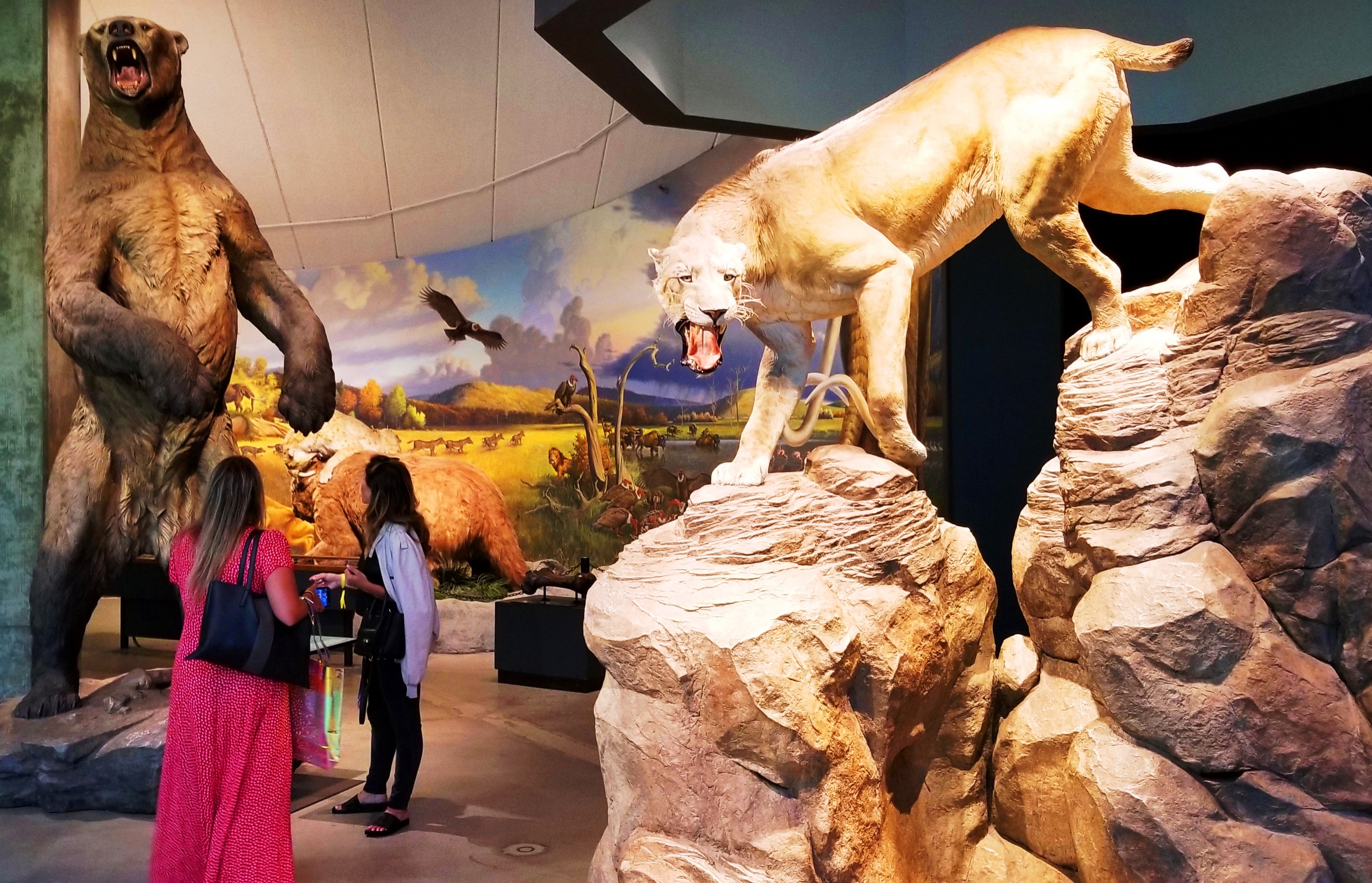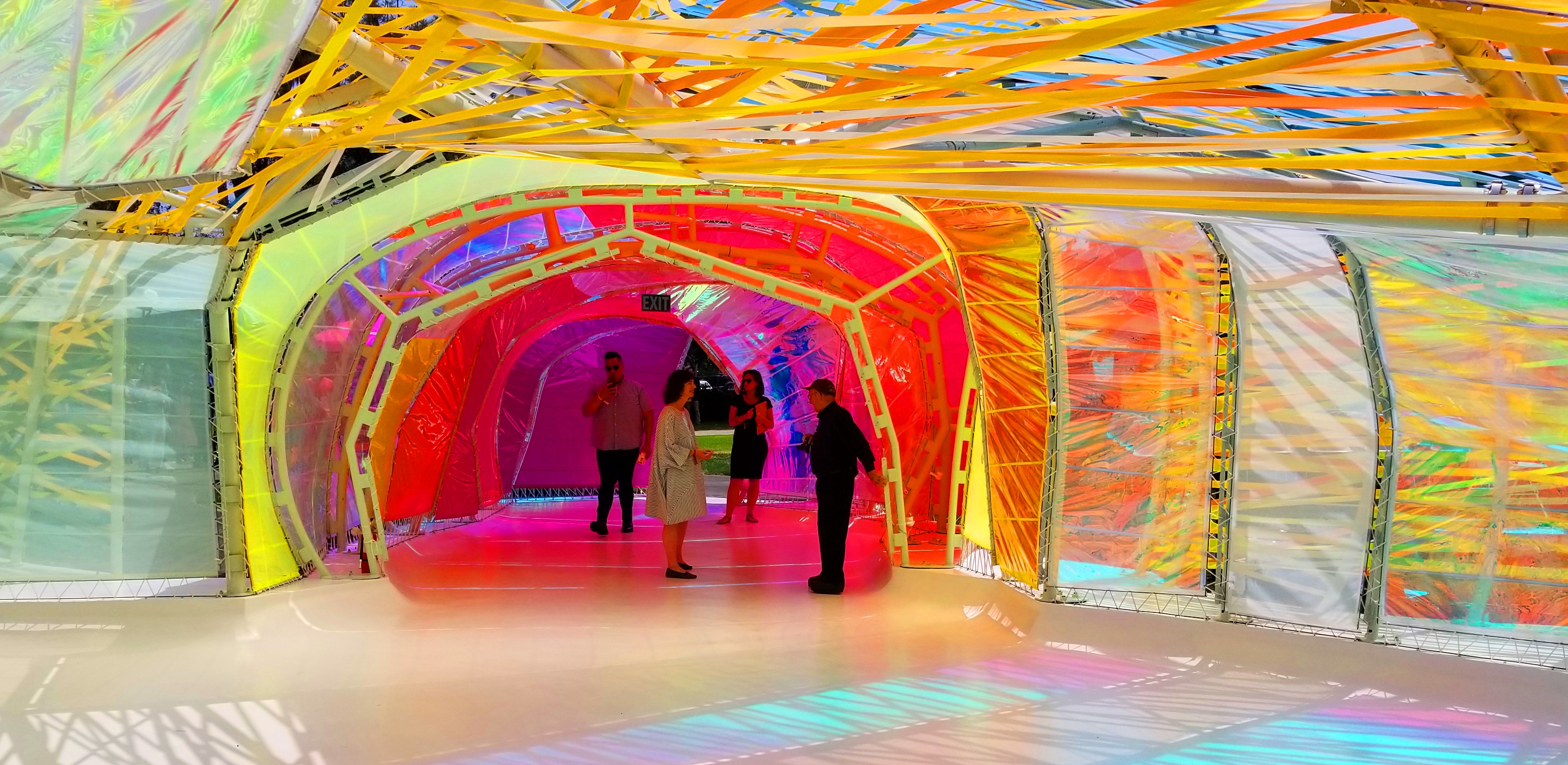
This post contains affiliate links and our team will be compensated if you make a purchase after clicking on the links.
Los Angeles has many fascinating sights, but nothing can match the history of mystery of the La Brea Tar Pits. This area of bubbling asphalt along Wilshire Blvd has intrigued scientists and visitors since it was discovered more than 100 years ago. As of today it is the only actively excavated Ice Age fossil site found in an urban location in the world.
I recently took an expedition to the La Brea Tar Pits to examine the fossil remains and to also see the new Second Home Serpentine Pavilion, a colorful temporary structure that is both a giant piece of art and a functioning public space.
My tour of the tar pits began in the main gallery, where I encountered large ground sloths, massive mammoths, and menacing saber-toothed cats. I also got a chance to look inside a real working lab to watch scientists prepare specimens found on site.
The biggest and most impressive display in the gallery is the Columbian mammoth. Standing nearly 14 ft-tall and weighing some 17,000 pounds this giant proboscidean mammal roamed what is now Los Angeles between 11,500 and 1.6 million years ago. The Columbian mammoth is recreated at La Brea Tar Pits with actual skeletal remains and also with a giant, life-sized model.

Another ancient animal found onsite is the giant ice age bear, which lived 12,000 to 1.5 million years ago. With the help of a giant replica, the museum brings this massive creature to life, giving visitors a scary glimpse of the largest carnivore during the last ice age.
The discovered bones of other extinct animals on display include the American Lion, which resembled today’s lions; the extinct camel, which lived about 45 million years ago; the California saber-tooth cat, with its huge fang-like teeth; the Dire Wolf; and the American mastodon.
So visitors can get an idea of how the bones are cleaned and prepared, there is a working lab in the middle of the museum that is surrounded by windows so guests can watch paleontologists at work.
While touring the museum I learned a lot of history about the tar pits. Over the last 50,000 years, Ice Age animals, plants, and insects were trapped and preserved in sticky tar, which is actually asphalt. More than 100 excavations have been made at the Tar Pits since the early 1900s, and most of the fossils discovered here are housed onsite. The discoveries range in size from huge, extinct mammoths and sloths to “microfossils,” or tiny remains of plants and animals that give us clues about how ancient ecosystems and climates changed. Since opening, the museum has excavated over 3.5 million fossils from the Tar Pits, and they are still digging.
Besides all the incredible bones on display, the museum is also showing a movie called Titans of the Ice Age, which is an additional $5 on top of admission. In this mesmerizing 3D adventure, narrated by Christopher Plummer, viewers will discover an icy world on the brink of extinction, where humans share the frozen tundra with majestic beasts. The movie is a great way to see how these magnificent creatures lived 10,000 – 50,000 years before humans, and how they became trapped in tar, preserved in time, and are being unearthed today at the Tar Pits.
Outside the museum are actual bubbling tar pits, including the large Lake Pit that welcomes visitors near the front entrance. Leftover from asphalt mining work in the 1800s, the pit is highlighted by mammoth trapped in tar.

Across the lawn from this pit is the new Serpentine Pavilion, designed by Spanish architect selgascano. Organized by Second Home, a London-based workspace business, the 866-sq-ft chrysalis-like structure is covered in a translucent, multi-colored fabric membrane, allowing the public to experience architecture “through shape, light, transparency, color, and materials.”
The pavilion offers the public a flexible, multi-purpose social space in which to enjoy public programs and events focusing on the intersection of art, design, science, and nature. The Second Home Serpentine Pavilion will be at La Brea Tar Pits from June 28 to November 24, 2019.
The La Brea Tar Pits is located at 5801 Wilshire Blvd., Los Angeles, 90036. Adult admission is $15 and parking is $15. For more information, call 213.763.3499 or visit www. tarpits.org











